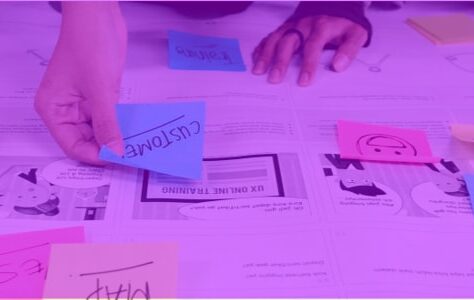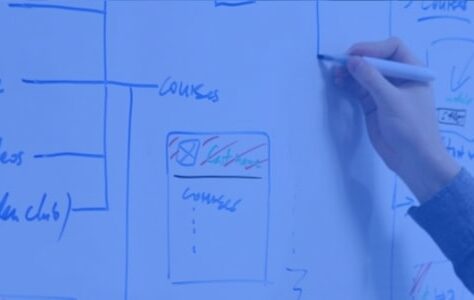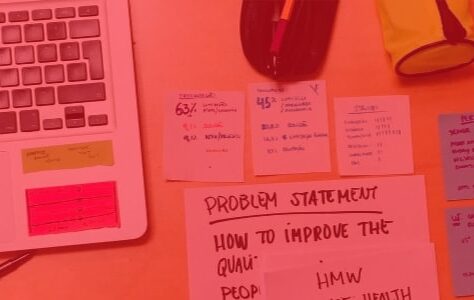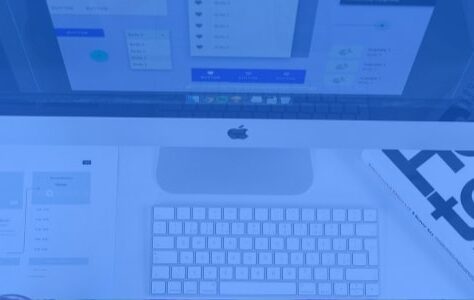Excellent meetup, organized by Laurent Meurisse and hosted by Bouygues Télécom on February 11. We arrive a few minutes early, the amphitheater is already full. The conference is part of a series proposed by the group Lean startup & implementation (effecting = obtaining effects). The decor is set.
Bouygues Telecom
Jeremiah Chain,UX Designer and Celine Pineau, sociologist
Jérémie presents the epic of a UX designer within a large group to evangelize and ensure that UX is integrated upstream of agile projects. Among the issues are industrialization best practices, iterative design, prototyping fast and the testing. He shows us the evolution of a model and insists on the importance of giving visibility to his work, by displaying screens on the wall for example. In the same vein, the prototypes made with Axure are tested and the videos broadcast to the entire project team to convince. It is this approach, very factual and based on measurement and observation reality that establishes the legitimacy of UX within the Company. Céline also presents the methods Quali-Crea for collaborative design and Street Quality for user evaluation. A form of Guerrilla testing, very pragmatic, raw formwork and extremely efficient.
Air France
Alicia Bogouslavsky, UX Manager and Sebastien Sacard, Lean Product Management Consultant
Alicia and Sébastien share feedback on a first approach Lean-UX within Air France. Their approach consists of 5 steps: Discover, design, develop, launch and improve. The UX Designer intervenes in stages 1 and 2 then at the end for the iterative improvement.
The presentation does not evade the difficulties encountered, for example, the discovery phase which did not allow new insights to be discovered… or the fact that the project was stopped before the development phase. That said, it's very interesting to see that after the design phase, the team was able to conduct design tests with a feedback loop on the prototype.
Some numbers:
- A week of testing with testing every other day and modification of the prototype in the meantime.
- 15 testers
- 3 indicators: success in the 6 scenarios, obtaining a strong signal on understanding the HMI, obtaining a strong signal on the perception of the value of the service
In her conclusion, Alicia recalls that the competitive context is becoming more radical, so the business point of view must be integrated throughout the process.
Blablacar
Julien pelletier, Experience Designer
The notion of'experience goes way beyond interface design. For example, 99% of the Airbnb experience is offline. Beyond the interfaces, the design of this experience also consists in defining the guidelines to properly prepare his apartment. He also cites the startup Lyft and its iconic pink mustaches to define a differentiating customer experience.
At blablacar, user research is based on a data analyst who provides analyzes quantitative and a member voice coordinator who provides analysis qualitative. The quality of the UX and the success of the projects largely depends on these two inputs.
Julien has optimized and equipped the UX production chain :
- Sketch to design the interface
- Invision to make it clickable
- Framer for transitions/animations
- Zeplin to export assets for developers
The first tool allows him to gradually move from prototypes low fidelity à high fidelity. Prototypes are shared with the team who test as they go. He makes sure to be a sprint ahead of the developers.
"an interface is like a joke: if you have to explain it, it's no good"
Julien then mentions the “Polish test”: translating the interface into Polish and seeing if the interface remains understandable (and without bugs). It ends with the adaptation of interfaces to different markets. The same interface cannot be optimized for both 100 and 5000 items. So there is redesign work et optimization to ensure that the interface always delivers a positive experience. For example :
- a search for Paris returns hundreds of results, the interface offers by default restrict depending on the starting district to limit the number of results
- on the contrary, a search from a district of Wroclav may not provide a result. For increase the number of results, the search is widened by default to neighboring localities and extended in time by adding a day before and a day after.
In both cases, the intention is the same: to maximize the chances that the user finds what he is looking for and to convey a positive image of the service. Finally, it monitors analytics to assess the use (and therefore the value) of each new feature and measure the relevance of design changes. It's exciting and very convincing!
iErgo
Raphael Yharrassarry, Ergonomist, UX, Psychologist, freelance
There is a big difference between perception innovation for the customer (minority report, the holographic interface of Iron man) and UX innovation (the search for simplicity). The demonstration is very strong insofar as we have all been confronted with it.
Raphael presents a very nice approach to redesigning a remote control, based on observation and measurement. A graph represents the frequency of use of each button. The design draws on this information to make large buttons for the most useful functions and minimize or remove unused functions. Simply !
Finally, it takes the opposite view of agile methods, by showing projects that have put between two and four years of study and production before being put on the market… or abandoned. With this demonstration by the absurd, we see that speed has become a key factor in the success of innovation, while ensuring that time is left for upstream user meetings and UX design work.
Conclusion
The implementation of Lean UX approaches is making great strides. Without excessive dogmatism, everyone does their best to experiment, learn lessons in order to iteratively improve, not only the products, but also the approach. New standards are emerging.
Thank you to all the speakers and organizers for this very good meetup.
Antoine Visonneau
UX/UI ECO-DESIGN # Paris
SMILE Paris
163 quay of Doctor Dervaux 92600 Asnières-sur-Seine
DESIGN THINKING: CREATING INNOVATION # Belgium
UX-REPUBLIC Belgium
12 avenue de Broqueville - 1150 Woluwe-Saint-Pierre
MANAGING AND MEASURING UX # Paris
SMILE Paris
163 quay of Doctor Dervaux 92600 Asnières-sur-Seine
DESIGN SPRINT: INITIATION & FACILITATION # Paris
SMILE Paris
163 quay of Doctor Dervaux 92600 Asnières-sur-Seine
UX-DESIGN: THE FUNDAMENTALS # Belgium
UX-REPUBLIC Belgium
12 avenue de Broqueville - 1150 Woluwe-Saint-Pierre
GOOGLE ANALYTICS 4 #Paris
SMILE Paris
163 quay of Doctor Dervaux 92600 Asnières-sur-Seine
ACCESSIBLE UX/UI DESIGN # Belgium
UX-REPUBLIC Belgium
12 avenue de Broqueville - 1150 Woluwe-Saint-Pierre
EXPERIENCE MAPPING # Paris
SMILE Paris
163 quay of Doctor Dervaux 92600 Asnières-sur-Seine












